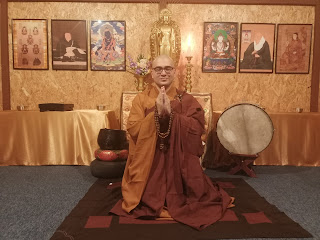After much thought, prayer, discussion and contemplation of various options, I finally decided that the Stupa of All Buddhas to be built at Amidaji will be inspired by the Dhamek Stupa (👈left image) which is located in the Deer Park at Sarnath in the state of Uttar Pradesh, India.[1] The reasons are many, among which I mention the following,
- its style is better suited for a
non-sectarian stupa: it is clearly not Tibetan, not Japanese, not Chinese, etc,
but a simple Indian stupa style to which any Buddhist can relate to - nobody can say, “this stupa belongs to a
Tibetan, Chinese, Japanese school, etc”, but simply see it as a stupa.
- its form is simple and easier to
build locally, without the sophisticated architecture of a Tibetan chorten[2] or Japanese/Chinese pagoda
- as Dhamek stupa commemorates the first teaching of the Buddha it is very suitable as an inspiration for the Stupa of All Buddhas which represents the Teaching of all Buddhas









.jpeg)


.jpeg)












.jpeg)


















